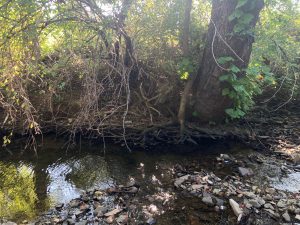 The time was about 3:50pm on Tuesday, September 22nd when I arrived at my sit spot. According to my compass app, my sit spot is located at 37° 21’ 32” N 79° 56’ 60” W. I am seated on the back of Carvin Creek, about 2.5 miles south of I-81. There is a large sycamore tree in front of me, a fallen tree with gnarled roots dipping into the water slightly to the left, and a fallen ash tree that spans from both sides of the creek about 20 feet downstream. Located behind me through the woods is a gravel path that leads back to campus if you head south and the derby field where horseback riders go to hack. Once settled, I immediately noticed how the heavy rainfall from the days before had impacted the creek. The water had risen just a bit and the channels that connected the upper pool to the lower creek seemed to be a bit deeper.
The time was about 3:50pm on Tuesday, September 22nd when I arrived at my sit spot. According to my compass app, my sit spot is located at 37° 21’ 32” N 79° 56’ 60” W. I am seated on the back of Carvin Creek, about 2.5 miles south of I-81. There is a large sycamore tree in front of me, a fallen tree with gnarled roots dipping into the water slightly to the left, and a fallen ash tree that spans from both sides of the creek about 20 feet downstream. Located behind me through the woods is a gravel path that leads back to campus if you head south and the derby field where horseback riders go to hack. Once settled, I immediately noticed how the heavy rainfall from the days before had impacted the creek. The water had risen just a bit and the channels that connected the upper pool to the lower creek seemed to be a bit deeper.
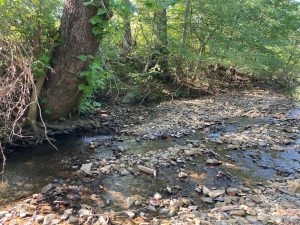 I started my observation by listening to my surroundings. Not much had changed from my previous sitting. The road still droned on to the north, cicadas still sang to each other from above and around me, and the creek still gurgled along in front of me, although I believe it was a bit louder and faster flowing. I heard the soft calls of songbirds every so often and the clatter of wood in the back of a work truck from the field across from me to the west. Once I opened my eyes, I noticed how the sun dazzled on spiderwebs on a low handing branch above the creek. They were caught by the wind, altering the sunshine on each strand, seeming to be almost iridescent. Overall, my surroundings had not changed much. The bed of the creek had deepened due to the strong currents brought upon by the rain and the bright flowers that once stood out against the brush began to wilt and die as autumn approached, but the trees still and shrubbery still held their bright green coloration. The air felt cool and comfortable on my skin, a light breeze keeping everything moving. The sun shone brightly before me as it began to fall closer to the horizon, but only some of its warm rays managed to reach me, as I was protected by the shady canopy of leaves above me.
I started my observation by listening to my surroundings. Not much had changed from my previous sitting. The road still droned on to the north, cicadas still sang to each other from above and around me, and the creek still gurgled along in front of me, although I believe it was a bit louder and faster flowing. I heard the soft calls of songbirds every so often and the clatter of wood in the back of a work truck from the field across from me to the west. Once I opened my eyes, I noticed how the sun dazzled on spiderwebs on a low handing branch above the creek. They were caught by the wind, altering the sunshine on each strand, seeming to be almost iridescent. Overall, my surroundings had not changed much. The bed of the creek had deepened due to the strong currents brought upon by the rain and the bright flowers that once stood out against the brush began to wilt and die as autumn approached, but the trees still and shrubbery still held their bright green coloration. The air felt cool and comfortable on my skin, a light breeze keeping everything moving. The sun shone brightly before me as it began to fall closer to the horizon, but only some of its warm rays managed to reach me, as I was protected by the shady canopy of leaves above me.
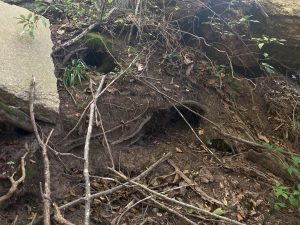
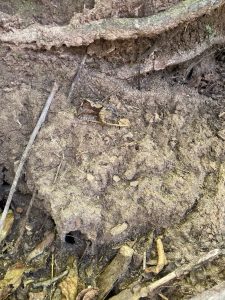 As I began to wander my sit spot, I took notice of things I had not paid much attention to before. Although I did not spot any birds nearby, I discovered fresh droppings on the creekside. The first thing I wanted to closely examine was the burrows among the tree roots upstream. I looked for tracks nearby the lead to the burrows, but I could not find anything definite. The dirt seemed to be weathered by the rain, giving it a marbled look. Regardless, I believe these burrows are still in use. As I made my way back downstream, I took notice of how many hornbeam trees there were along the creek. I counted about 11 or 12 just in my immediate area. I also took notice of the rusty metal that had claimed a small section of the creek. The cloudy, orange stained water seemed to glow like a flame in the rays of the setting sun. Once I returned to my original location, I examined the large sycamore tree. I noticed how, as the tree gets taller, less bark covers the highest branches, giving it a light, bleached-out look. Several leaves on the tips of the outermost branches were beginning to turn a russet-orange color, but the tree still stood lush with large, green leaves. Finally, I examined the level and condition of the creek. The water level only seemed to be a bit higher than my last sitting, but the heavy rain had deepened the paths it flowed along. I took note of how bare the shore was. I assumed this was because of its strong currents eroding away at the bank as water levels rose.
As I began to wander my sit spot, I took notice of things I had not paid much attention to before. Although I did not spot any birds nearby, I discovered fresh droppings on the creekside. The first thing I wanted to closely examine was the burrows among the tree roots upstream. I looked for tracks nearby the lead to the burrows, but I could not find anything definite. The dirt seemed to be weathered by the rain, giving it a marbled look. Regardless, I believe these burrows are still in use. As I made my way back downstream, I took notice of how many hornbeam trees there were along the creek. I counted about 11 or 12 just in my immediate area. I also took notice of the rusty metal that had claimed a small section of the creek. The cloudy, orange stained water seemed to glow like a flame in the rays of the setting sun. Once I returned to my original location, I examined the large sycamore tree. I noticed how, as the tree gets taller, less bark covers the highest branches, giving it a light, bleached-out look. Several leaves on the tips of the outermost branches were beginning to turn a russet-orange color, but the tree still stood lush with large, green leaves. Finally, I examined the level and condition of the creek. The water level only seemed to be a bit higher than my last sitting, but the heavy rain had deepened the paths it flowed along. I took note of how bare the shore was. I assumed this was because of its strong currents eroding away at the bank as water levels rose.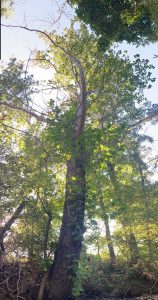

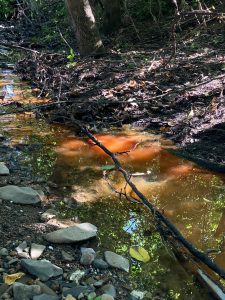
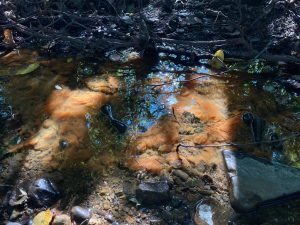 During my observation, I did not see as many creatures as I heard. I noticed the usual buzzing flies, ants, and water skeeters, but what really stood out to me were the spiders. They seemed to have made their webs in the most insect-rich airspace above the creek, favoring low-hanging branches to catch the most food. Taking a closer look, a skinny, orangey-brown spider with very long legs intrigued me. As I got closer, the spider took notice of me, but it did not scurry to a nearby branch like I thought it would. Instead, the spider dropped immediately down off its web, hanging just over the water, and straightened itself out like a twig. It sat there for a good amount of time, dangling from a strand of web like a stick in the breeze, even after I sat back down. I found this adaptation to be unique, especially for a spider. My attention was then drawn to a squirrel bounding through the trees. I could hear the clatter of nuts hitting the stones below as the squirrels dropped them from high up. I supposed they did this to break open the nut to get the meat inside, but I could be wrong.
During my observation, I did not see as many creatures as I heard. I noticed the usual buzzing flies, ants, and water skeeters, but what really stood out to me were the spiders. They seemed to have made their webs in the most insect-rich airspace above the creek, favoring low-hanging branches to catch the most food. Taking a closer look, a skinny, orangey-brown spider with very long legs intrigued me. As I got closer, the spider took notice of me, but it did not scurry to a nearby branch like I thought it would. Instead, the spider dropped immediately down off its web, hanging just over the water, and straightened itself out like a twig. It sat there for a good amount of time, dangling from a strand of web like a stick in the breeze, even after I sat back down. I found this adaptation to be unique, especially for a spider. My attention was then drawn to a squirrel bounding through the trees. I could hear the clatter of nuts hitting the stones below as the squirrels dropped them from high up. I supposed they did this to break open the nut to get the meat inside, but I could be wrong.
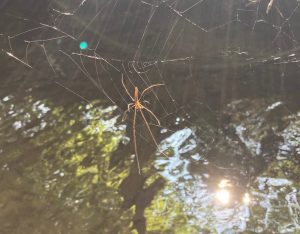
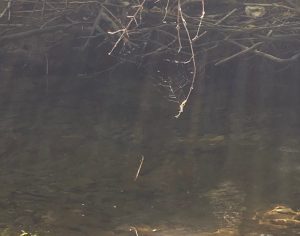
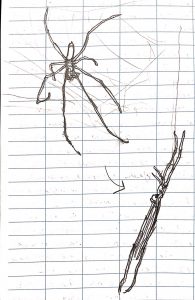
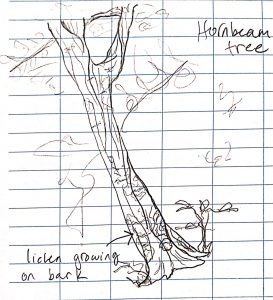
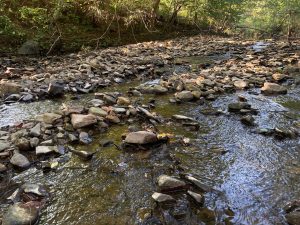 I left my sit spot around 5:22pm on Tuesday, September 22nd. I enjoyed walking around my sit spot, discovering all I could find. I find walks through the woods to be a very interesting way to spend the time, especially if there is wildlife around. Even inspecting the various plants and how they grow in the wilderness can be enjoyable as well if you know where to look. I do not believe the world can ever be boring so long as you are patient and keep your eyes open. The smallest details are often the most rewarding.
I left my sit spot around 5:22pm on Tuesday, September 22nd. I enjoyed walking around my sit spot, discovering all I could find. I find walks through the woods to be a very interesting way to spend the time, especially if there is wildlife around. Even inspecting the various plants and how they grow in the wilderness can be enjoyable as well if you know where to look. I do not believe the world can ever be boring so long as you are patient and keep your eyes open. The smallest details are often the most rewarding.

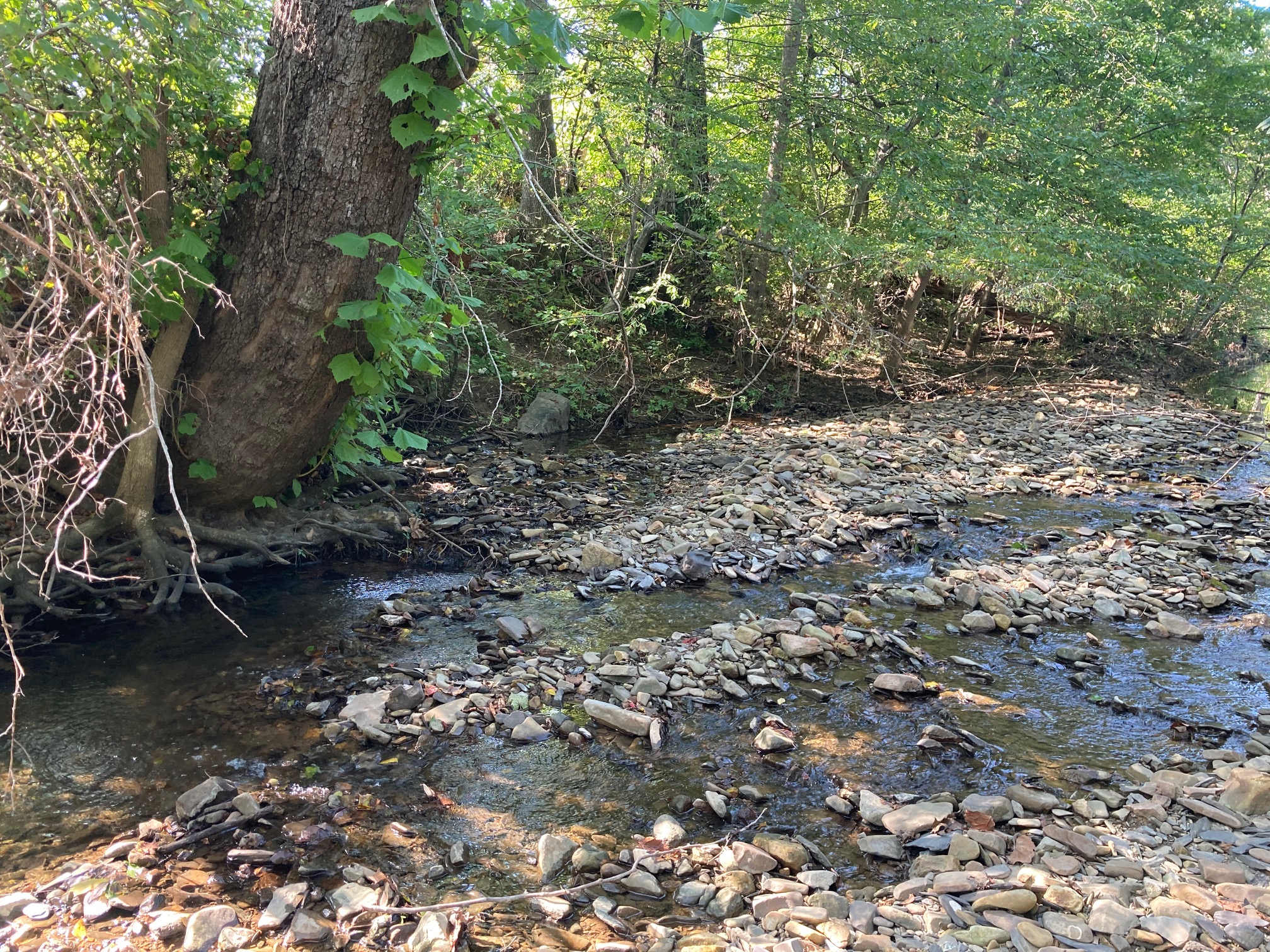
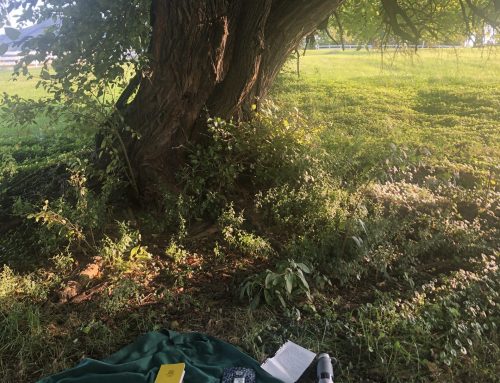
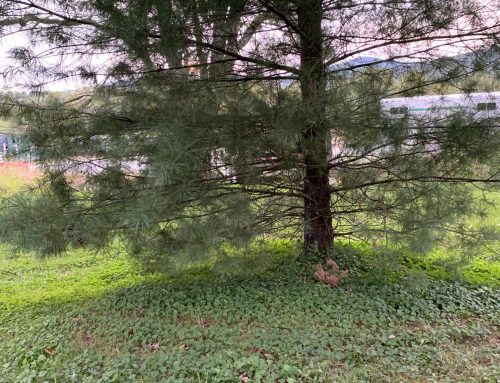
Hi, I really loved all the pictures you took at your sit-spot and how the sun is peeking through various trees and shining down onto the water. They are very nice to look at. Secondly, I like how descriptive you are when describing the things you are seeing, hearing, and all around describing your sit spot. It makes reading the blog very immersive like I’m there as well experiencing the exact same things. I hope you end up finding what is occupying the burrows in a future sit-spot!